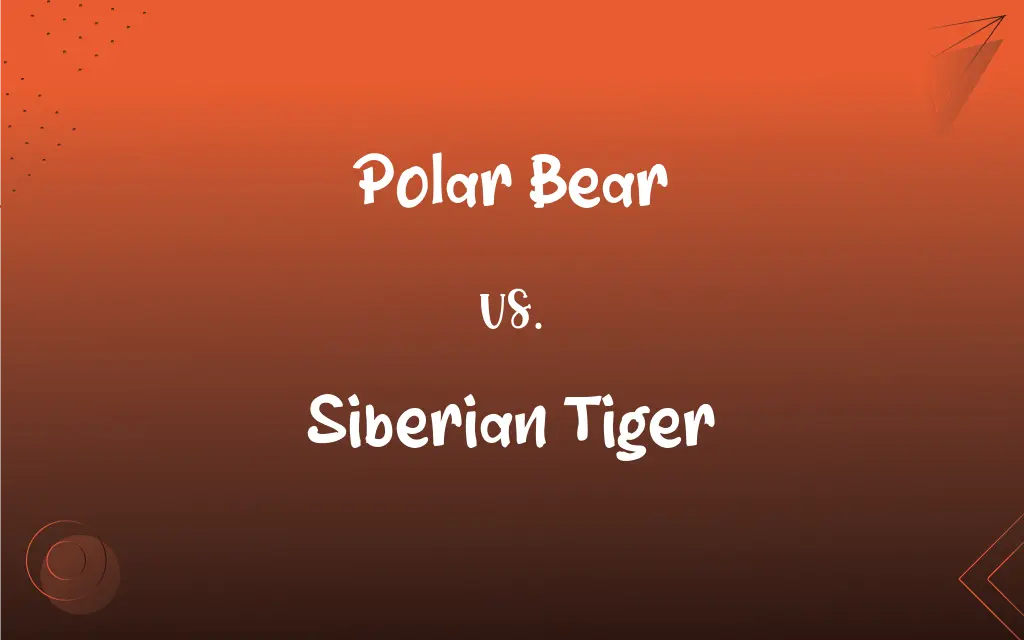Polar Bear vs. Siberian Tiger: What's the Difference?
Edited by Harlon Moss || By Janet White || Published on November 1, 2023
Polar bears are large, white-furred bears native to Arctic regions, while Siberian tigers, orange with black stripes, inhabit the Siberian forests.

Key Differences
Polar bears are prominently recognized for their thick, white fur and large body size, enabling them to survive in harsh, Arctic conditions. Siberian tigers, on the other hand, are known for their distinctive orange coat with black stripes, adapting them for the dense, shadowy Siberian forests.
The primary diet of the polar bear consists mainly of seals, adhering to a largely carnivorous diet suitable for Arctic life. The Siberian tiger, in contrast, hunts various prey like deer and wild boar, showcasing its adaptive predatory skills across diverse Siberian ecosystems.
Polar bears are exemplary swimmers, capable of traversing large distances across the ocean, an essential skill in their icy, water-laden habitats. Siberian tigers, conversely, are robust runners and climbers, navigating skillfully through dense, forested terrains.
When considering reproductive behaviors, polar bears mate during April and May, leading to the birth of typically one to three cubs after about eight months. Siberian tigers breed throughout the year, producing litters of two to six cubs after approximately three and a half months.
Vulnerability due to climate change is a pressing issue for polar bears, as melting ice caps directly threaten their hunting grounds and habitat. Siberian tigers also face peril, majorly from poaching and habitat loss, driving their status towards being endangered.
ADVERTISEMENT
Comparison Chart
Habitat
Arctic ice floes and water
Siberian forests
Coloration
White
Orange with black stripes
Typical Prey
Seals
Various, e.g., deer, wild boar
Reproduction
1-3 cubs, 8 months gestation
2-6 cubs, 3.5 months gestation
Main Threats
Melting ice caps, climate change
Poaching, habitat loss
ADVERTISEMENT
Polar Bear and Siberian Tiger Definitions
Polar Bear
Endangered Species
The polar bear faces threats like climate change, categorizing it as an endangered species.
Siberian Tiger
Apex Predator
The Siberian tiger sits atop its food chain, hunting a wide array of prey.
Polar Bear
Arctic Predator
The polar bear hunts primarily on Arctic ice floes.
Siberian Tiger
Largest Cat
The Siberian tiger is acknowledged as one of the largest cats globally.
Polar Bear
Ursus Maritimus
Polar bears, scientifically known as Ursus maritimus, are fascinating Arctic creatures.
Siberian Tiger
Panthera Tigris Altaica
The Siberian tiger, or Panthera tigris altaica, inhabits Eastern Russia's forests.
Polar Bear
White-Furred
The polar bear is easily identified by its dense, white fur.
Siberian Tiger
Endangered Feline
The Siberian tiger is endangered, mainly due to poaching and habitat fragmentation.
Polar Bear
Marine Mammal
The polar bear is a skillful swimmer, often termed a marine mammal.
Siberian Tiger
Stripey Coat
The Siberian tiger's coat, adorned with black stripes, provides perfect forest camouflage.
FAQs
Siberian Tiger
What is the scientific name of the Siberian tiger?
About Author
Written by
Janet WhiteJanet White has been an esteemed writer and blogger for Difference Wiki. Holding a Master's degree in Science and Medical Journalism from the prestigious Boston University, she has consistently demonstrated her expertise and passion for her field. When she's not immersed in her work, Janet relishes her time exercising, delving into a good book, and cherishing moments with friends and family.
Edited by
Harlon MossHarlon is a seasoned quality moderator and accomplished content writer for Difference Wiki. An alumnus of the prestigious University of California, he earned his degree in Computer Science. Leveraging his academic background, Harlon brings a meticulous and informed perspective to his work, ensuring content accuracy and excellence.






































































